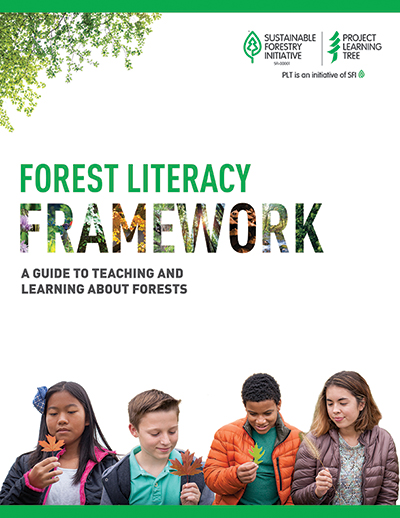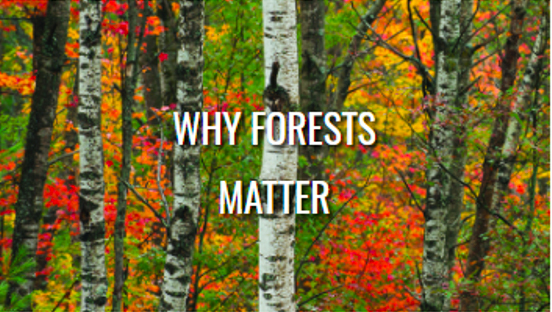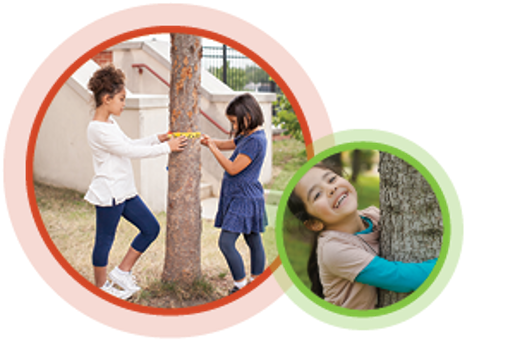The Forest Literacy Framework is designed to increase people’s understanding of forests and empower them to take actions that benefit forests and people. The framework, which is available for US and Canadian audiences, translates the complex language of forests, trees, forest practices, and sustainable forest management into concepts that are appropriate for ages five through eighteen. The document presents a learning pathway for educating communities and K-12 students about forests, with the goal of a forest-literate future.
Forests and our shared future
Now more than ever, people are waking up to the fact that sustainably managed forests offer solutions to some of the world’s biggest challenges. Forests mitigate climate change by capturing carbon from the atmosphere, and wood products from forests store carbon. Forests help conserve species at risk by providing habitat. Forests also purify air and water and reduce the threat of droughts and floods.

Forests are part of a renewable supply chain for products we use every day, reducing our reliance on non-renewable and less sustainable materials like plastic. Renewable forest products are also part of a circular economy that minimizes the depletion of non-renewable resources.
Forests are renewable. They are reliable, regenerative, and restorative. Forests sustain communities and economies by supporting diverse career opportunities and driving economic activity. Providing recreational spaces and sustaining traditional resource uses and places for spiritual renewal are yet other areas where forests play an outsized role.
The framework offers suggestions to explore the following “Hot Topics,” which all relate to current events reliant on environmental concepts, organized by age and grade level:
- Public health
- Climate change
- Urban forests
- Green jobs
- Wildfire
“The Forest Literacy Framework is something our profession has needed for a long time. I am excited to get it out to those who work in forests and those who teach about forests.”
—Donna K. Rogler
Forestry Education Specialist, Indiana Department of Natural Resources Division of Forestry
A framework that uses education to build support for forests

The Forest Literacy Framework offers 100 forest concepts, organized into four themes:
- What is a forest?
- Why do forests matter?
- How do we sustain our forests?
- What is our responsibility to forests?
Each theme includes topics and concepts that address its central question, with examples tailored for Canadian or US audiences. The themes and concepts build on each other, enabling individuals to progress from basic awareness to a deeper understanding of forests.
“It’s critical that we, as a society, learn to see and understand these values. Building this awareness requires a broad approach that includes youth, consumers, advocates, economists, scientists, teachers, and many others involved in the forest and conservation sector. Understanding our connection to trees needs to start at an early age and grow throughout our lives.”
—Tara Topping
Secondary School Teacher, Ottawa, Ontario
An interdisciplinary approach focused on results
The Forest Literacy Framework provides a conceptual outline for those who educate young people in formal or nonformal settings, create education policy or curricula, or advocate for forests. The US and Canadian versions link forest concepts to relevant examples, management styles, and activities for each country.
- For forest landowners and managers, the Forest Literacy Framework provides a way to organize our messages about forests. It will support their outreach in conservation education initiatives that they undertake, such as forest field days, hosting visitors to their land.
- For classroom teachers, the Forest Literacy Framework offers forest connections to existing curriculum, no matter the subject area. In both Canada and US, there are strong connections to science. There is also a high level of opportunity for environmental studies, language arts, mathematics, social studies, technology, and more.
- For public agencies, the Forest Literacy Framework identifies the most important concepts that we want the public to understand about forests and their sustainable management.
- For students, the Forest Literacy Framework brings relevance to their learning and multiple options for career pathways.
Critical thinking, complex systems, and cross-curricular connections are central to teaching and learning about forests and trees. Forest literacy is a truly interdisciplinary endeavor, with connections from social studies and mathematics to health and business and many subjects in between.

“It is nice to have a resource like the Forest Literacy Framework available to help promote the benefits of learning about our forest ecosystems across all grade levels. This gives educators and school administrators a blueprint on how to and what students should know.” ”
—Rob Beadel
Director of Forestry Education, Arkansas Forestry Association Education Foundation
Learn More
Download the free Forest Literacy Framework for US audiences or Canadian audiences, and visit plt.org/forestliteracy or pltcanada.org/forest-literacy to learn more about this new resource and explore ways to educate about the importance of forests using age-appropriate concepts.
By Jaclyn Stallard, Director of Curriculum, SFI
